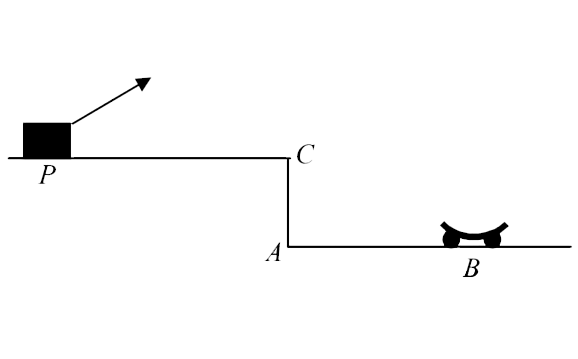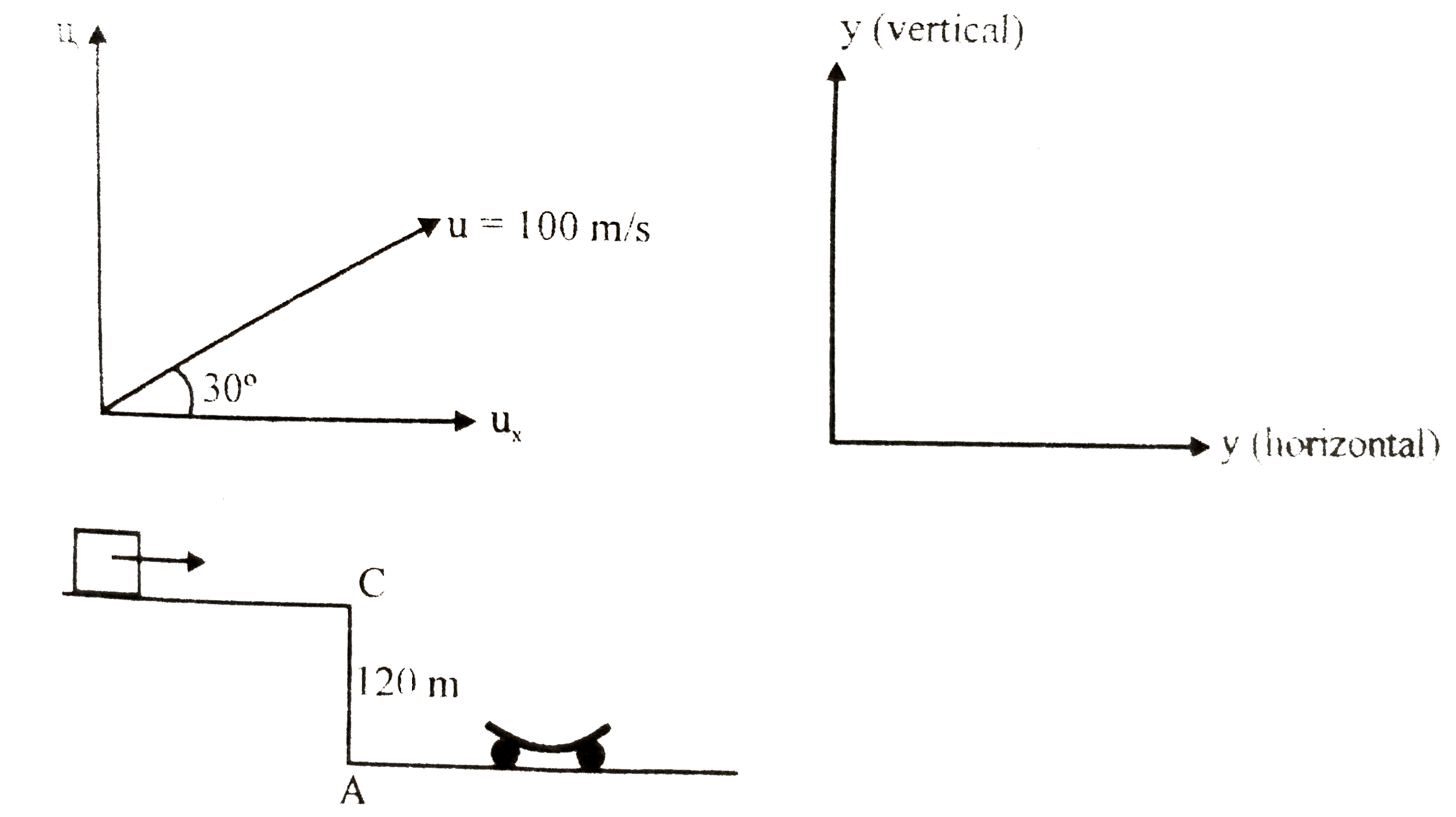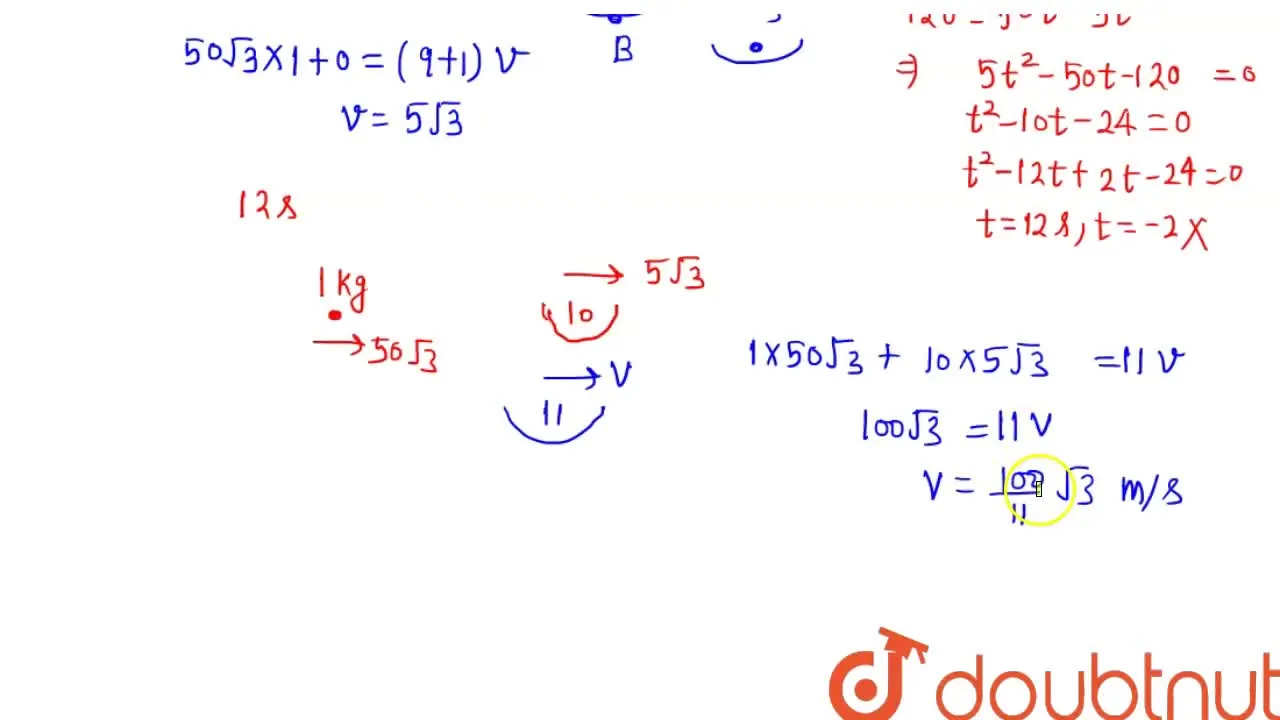A car P is moving with a uniform speed 5√3m/s towards a carriage of mass 9 kg at rest kept on the rails at a point B as shown in figure. The height AC is 120 m. Cannon balls of 1 kg are fired from the car with an initial velocity 100m/s at an angle 30∘ with the horizontal. The first cannon hall hits the stationary carriage after a timet0 and sticks to it. Determine t0.

At t0, the second cannon ball is fired. Assume that the resistive force between the rails and the carriage is constant and ignore the vertical motion of the carriage throughout. If the second ball also hits and sticks to the carriage, what will be the horizontal velocity of the carriage just after the second impact?
The correct Answer is:t0=12sec,v=100√3/11
(a) 100m/s velocity of the ball is relative to ground
[Unless and until it is mentioned in the question, the velocity is always relative to ground]

Horizontal component of velocity of cannon ball,
ux=ucos30∘
or ux=(100)×√32=50√3m/s
and vertical component o its velocity
uy=usin30∘
uy=100×12=50m/s
and vertical displacement of the ball when it strike the carriage is −120m or
sy=uyt+12ayt2
⇒ −120=(50t)+(12)(−10)t2
⇒ t2−10t−24=0t=12s or−2s
Ignoring the negative time, we have
(b) When it strikes the carriage, its horizontal component of velocity is still 50√3m/s. It strikes to the carriage. Let v2 be the velocity of (carriage+ball) system after collision. The applying conservation of linear momentum in horizontal direction
(mass of ball) (horizontal component of its velocity before collision)=(mass of ball+carrigage)(v_(2))<br> therefore" "(1 kg)(50sqrt3m//s)=(10 kg)(v_(2))<br>therefore" "v_(2)=5sqrt3m//s<br>Thesecondballisfiredwhenthefirstballstrikesthecarri≥i.e.after12s.Inthese12xthecarwillmoveforwardadistanceof12v_(1)or60sqrt3m.<br>Thesecondballalsotake12s→travelaverticaldisplacmentof-120m.Thisballwillstrikethecarria≥60sqrt3m∈these12s.Thisispossib≤onlywhenresistivecarria≥afterfirstcollision(v_(2))=5sqrt3m//s<br>Hence,atthetimeofsecondcollision<br>Horizontalcompo≠ntofvelocityofball=50sqrt3m//sandhorizontalvelocityofcarria≥+firstball= 5sqrt3m//s.Letvbethedisiredvelocityofcarria≥aftersecondcollision.Thenconservationoflilnearmomentum∈horizontaldirectiongives<br><imga≤ocr_imageload∈g=lazysrc=https://d10lpgp6xz60nq.cloudfront.net/physics_images/BSL_PHY_CMMC_E01_106_S02.pngwh=80%mx-autosty≤=background:white;><br>11v=(1)(50sqrt3)+(10)(5sqrt3)=100sqrt3<br>therefore" "v=(100sqrt3)/(11)m//sorv=15.75m//s
In this particular problem values are so adjusted that even it we that the velocity of ball with respect to car, we get the same results of both parts, although the method will be wrong.
Related Playlists
- BOOK - BANSALCHAPTER - CENTRE OF MASS & MOMENTUM CONSERVATIONEXERCISE - EXERCISE-4 (SECTION-A) (Comprehension)3videos
CENTRE OF MASS & MOMENTUM CONSERVATION
- BOOK - BANSALCHAPTER - CENTRE OF MASS & MOMENTUM CONSERVATIONEXERCISE - EXERCISE-4 (SECTION-B) (JEE-ADVANCED Previous Year Questions)8videos
CENTRE OF MASS & MOMENTUM CONSERVATION
- BOOK - BANSALCHAPTER - CENTRE OF MASS & MOMENTUM CONSERVATIONEXERCISE - EXERCISE-3 (Miscellaneous Exercise)30videos
CENTRE OF MASS & MOMENTUM CONSERVATION
- BOOK - BANSALCHAPTER - GRAVITATIONEXERCISE - EXERCISE -4 Section - B6videos
GRAVITATION
Similar Questions
A car P is moving with a uniform speed 5√3m/s towards a carriage of mass 9 kg at rest kept on the rails at a point B as shown in figure. The height AC is 120 m. Cannon balls of 1 kg are fired from the car with an initial velocity 100m/s at an angle 30∘ with the horizontal. The first cannon hall hits the stationary carriage after a timet0 and sticks to it. Determine t0.

At t0, the second cannon ball is fired. Assume that the resistive force between the rails and the carriage is constant and ignore the vertical motion of the carriage throughout. If the second ball also hits and sticks to the carriage, what will be the horizontal velocity of the carriage just after the second impact?View SolutionA cannon of mass 100 kg is kept on a frictionless floor. If a cannon ball of mass 1 kg is fired from it with a speed of 200 m/s. With what velocity the cannon will move ?
View SolutionA cannon of mass 100 kg is kept on a frictionless floor. If a cannon ball of mass 1 kg is fired from it with a speed of 200 m/s. With what velocity the cannon will move?
View SolutionA canon of mass 150 kg shot a cannon ball of 1.5 kg which goes with a velocity of 60 m/s. the cannon will recoil with a speed of
View SolutionA shell is fired from a cannon with a velocity 20m/s at an angle 60∘ with the horizontal. At the highest point it explodes into three pieces of equal masses . One of the pieces retraces its path to the cannon , the second piece moves vertically up with speed 40m/s , the third piece will move with velocity (immediately after the explosion)
View SolutionA shell is fired from a cannon with a velocity v(m/s) at an angle θ with the horizontal direction. At the highest point in its path it explodes into two pieces of equal mass. on, of the pieces retraces its path to the cannon and the speed, (in m/s) of the other piece immediately after the explosion is
View SolutionA shell is fired from a cannon with a velocity v(m/sec.) at an angle θ with the horizontal direction. At the highest point in its path it explodes into two pieces of equal mass. One of the pieces retraces its path to the cannon and the speed (in m/sec.) of the other piece immediately after the explosion is
View SolutionA shell is fired from a cannon with a velocity v(m/sec.) at an angle θ with the horizontal direction. At the highest point in its path it explodes into two pieces of equal mass. One of the pieces retraces its path to the cannon and the speed (in m/sec.) of the other piece immediately after the explosion is
View SolutionA cannon of mass 150 kg shot a cannon ball of 1.5 kg which goes with a velocity of 60 m/s. The cannon will 'recoil with a speed of
View SolutionA cannon of mass 150 kg shot a cannon ball of 1.5 kg which goes with a velocity of 60 m/s. The cannon will recoil with a speed o
View Solution


